WMO ABO Newsletter - Volume 25, May 2023
Welcome from the Chair of the JET-ABOOn behalf of the JET-ABO co-chairs and the WMO Secretariat, welcome to the April 2023 edition of the WMO Aircraft-Based Observations Newsletter. As many of you are aware, after 12 years with WMO, Dean Lockett, Scientific Officer, has accepted a position with the Bureau of Meteorology and will return to Australia in early June. Dean has been more than a Scientific Officer. He has been the global leader for ABO for more than a decade, coordinating our many activities, shepherding through WMO and its members significant advances and growth in the scope of our important contributions to the world meteorological community. There is no one else with Dean’s intricate technical and programmatic knowledge of the many facets of ABO, across governments, in international bodies, our partners in the aviation industry, and beyond. Dean is creative, passionate, and dedicated to anything he puts his mind to. Dean, we will miss you sorely and no doubt be at a loss for a while as we try to carry forward the work of the JET-ABO and the global programme, We wish you and Kath all the best in this next chapter of your lives. In this edition of the newsletter, we provide updates on the status of regional programmes, and a selection of articles featuring contemporary topics. Especially of interest are plans and priorities for the JET ABO and a contribution on the evolving status of ADS-B as a source of meteorological data. Also included are updates on water vapor measurement and turbulence monitoring as well as a look at Synoptic Data’s role in the ABO programme. In the last year we have increasingly returned to in-person engagement and meetings. For the rest of 2023, we can look forward to more events, including a planned meeting with an emphasis on stakeholder engagement with the broader components of the aviation industry important to ABO, such as avionics and communications providers. Also, a meeting planned for late in the year to be hosted by Deutschr Wetterdienst, Germany, will focus on future strategies for water vapor measurements. We also will take stock of the outcome of the WMO Congress in May and June and its impacts on our membership and work. We thank the authors of the articles for their time and effort and all involved in assembling this newsletter, with particular thanks to the newsletter editor, Mr Carl Weiss. curtis [dot] marshall |
A word from the outgoing scientific officerFirstly, thank you to Curtis for his very kind words in the welcoming article above. It has been my great privilege to have, over the past 12 years, had the role as a scientific officer, to coordinate the WMO Aircraft Based Observations Programme as one of my primary responsibilities. This has been one of the most satisfying and rewarding roles that I have had in my career of over 30 years in science and meteorology. I have been very fortunate to have been offered this opportunity, which has included, and been highlighted by, the privilege of working and collaborating with so many professional, dedicated and friendly international colleagues on this still developing area of observational meteorology. Together, we have achieved a great deal, and yet, of course, there is still so much more to do to improve and expand upon this important component of the WMO Integrated Global Observing Systems. In terms of the output of the programme, the achievements we have made together over the past 12 years include:
In this role, great support has been given and faith shown by WMO Member NMHS, who have supported the programme through contribution of resources to the AMDAR Operating Fund and through provision of time and effort of their own experts, without which nothing would have been achieved. Additionally, much support has been shown and given to both the programme and to me by my Secretariat colleagues and managers. I wish to sincerely thank all my colleagues for their wonderful support and collegiality over my time with WMO. I look forward to a continued connection with at least some of you in my new role with the Australian Bureau of Meteorology. Thank you. Dean Lockett, Scientific Officer, WMO Secretariat. |
Status of Aircraft Based ObservationsThe graphic below shows the smoothed monthly average of daily aircraft-based observations (single point measurements in space and time, mainly of air temperature and wind speed and direction, made by an aircraft) transmitted on the World Meteorological Organization (WMO) Global Telecommunications System (GTS) since 2007 up to October 2022, as contributed by:
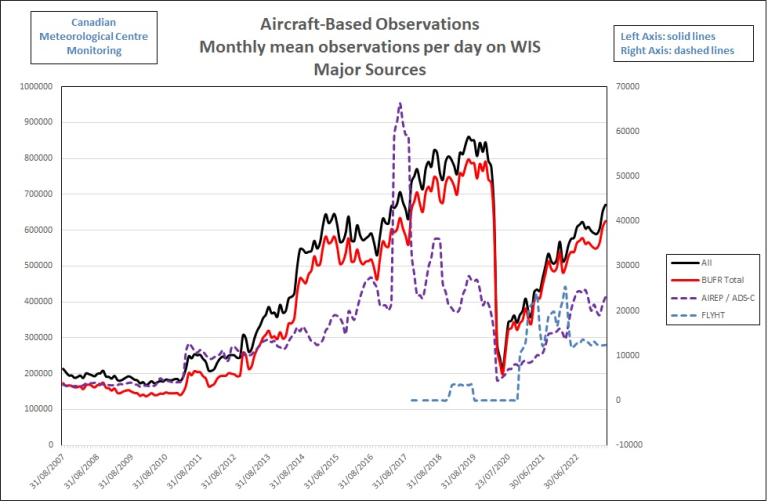
The observations from the WMO AMDAR observing system are the output from 12 operational AMDAR national and regional programmes in cooperation with some 43 national and international participating airlines, as listed on the WMO website. |
ABO Data Volumes and CoverageThe graph shows that recently towards the end of 2019 and start of 2020, aircraft-based observations data volumes had increased to a historical maximum of more than 850k observations per day on the GTS, with AMDAR observations making up the majority of these at around 750k observations per day. From March 2020, as a direct result of the impact of COVID-19 on the aviation industry and airlines, the volume of aircraft-based observations overall fell to around 245k observations per day and to 230k for AMDAR - around 30% of December data volumes for both. The biggest monthly reduction occurred in May 2020, with only an average of 210k observations per day available. Since then, data levels have gradually increased overall with mean daily total observations at around 670k observations per day in April 2023, which is around 80% of the December 2020 data volume. The graphic above, courtesy of NOAA, provides an indicative coverage of the full ABO observing system over a 4-hour period on 22 May 2023, with around 12% of available observations shown on the map. The colour provides an indication of the altitude of the observation, ranging from red at low altitudes when aircraft are taking off or landing, to light blue, indicating altitudes at cruise levels. |
Thanks to Program PartnersWMO and its Members are grateful to our aviation industry and airline partners for their continued contribution to the WMO Aircraft-based Observing System and the AMDAR Programme. The data that are produced from this collaboration are utilized within many meteorological applications and forecasts, benefiting aviation operations and safety, other application areas and the wider general public. For more information on aircraft-based observations data statistics visit the WMO Community Platform Aircraft-Based Observations site. |
Regional program status and developmentsWMO Region I, Africa, ABO StatusKenya WMO, Kenya Meteorological Department (KMD) and Kenya Airways (KQ) have recently established a new agreement for the continued operation of the Kenya Airways AMDAR system for the period 2023 - 2024. This implementation arrangement provides for WMO to support the ongoing communications costs for the 2 B737 reporting aircraft, and also to allow for the expansion of the fleet to include equipping the rest of the KQ B737 and Embraer 190 fleet, subject to required funding becoming available to support both the implementation and communications costs. Ethiopia As reported in this newsletter, a meeting of the RA-I Task Team on Aircraft-Based Observations (TT-ABO) and a workshop on WICAP was held in Addis Ababa, Ethiopia in December 2022. Representatives of both Ethiopian Airlines and the Ethiopia Meteorological Institute (EMI) attended the workshop where there was enthusiasm shown by both parties to work towards future establishment of an AMDAR programme. Discussion continues between the parties and the Regional Office for Africa to establish a way forward to implement the programme, subject to funding availability to support the implementation and ongoing communications costs. EMI expressed an interest in developing a future capability to receive and process AMDAR data in-house. Morocco EUMETNET, Royal Air Maroc (RAM) and Météo Maroc have recently recommenced the process of integrating RAM into the EUMETNET E-AMDAR programme based on equipping RAM's B738 fleet. An initial equipping of 5 aircraft would be undertaken with a larger rollout to take place when plans for integrating the fleet into the E-AMDAR data optimisation system were complete. A timeline for this development is not yet established. WMO Region III, South America, ABO StatusSince December 2021, LATAM Airlines has halted AMDAR data provision for all its branches across South America. Hence, there are no operational airlines providing this data in RA-III currently. However, several meetings have been held with Avianca Airlines in order to start a new regional program in Region III under WICAP with support from the US-ABO program. TT-ABO III activities During Q1 2023, the Chairs of Task Team on Aircraft-based Observation for Region III (TT-ABO III) and Expert Team on Surface-based observations and WICAP for Region IV (ET-SBW) met several times to work together under a new WICAP program for the Americas. This collaboration will enhance data provision from new participating airlines and will improve ABO coverage in data sparse areas of Central and South America. Argentina (AR)-AMDAR Communications with Aerolíneas Argentina have been reestablished in Q1 2023. Changes in their aircraft avionics are required to install AMDAR onboard Software (AOS) and to report data under WMO No.1200 requirements. Brazil (BR)-ABO The Brazilian ABO program also has not escaped the effects of the pandemic and the resulting cessation of LATAM AMDAR provision (fig. 1). While ADS-C data delivery is increasing during austral summer, AMDAR data from former TAM airlines have fallen to zero since January 2022. 
Figure 1. Brazilian ABO program data during 2022 and first two months of 2023. Blue bars represent ADS-C data. Source: Quilson Aragao Santos (DECEA - Brazil). |
US LATAM Program Because of pandemic-forced border and airspace closings since March 2020, the LATAM program has been seriously affected due to the bankruptcy of the airline. This, plus increased downlink regional costs and irregular economic recovery of the airlines, forced LATAM to stop providing data permanently as of December 2021. The US will continue to support the LATAM data stream processing when the airline is ready to start providing data again as the economy recovers. %20nrivaben |
WMO Region IV, North and Central America, ABO UpdateThe RA-IV Program consists of the USA and USA-based AMDAR enabled airlines and FLYHT TAMDAR and AFIRS-AMDAR as well as Mexico and AeroMexico, and Canada and Canadian data sources from FLYHT. The USA AMDAR program additionally provides ADS-C enroute wind and temperature reports approximately every 14 minutes on transonceanic and long-haul routes around the globe. As of April 2023, the USA, in partnership with RA-III and WMO, continues to pursue a replacement for the loss of LATAM in South America with a particular emphasis on Avianca. Additionally, following the outcome of the RA-I ABO workshop in Addis Ababa, Ethiopia in December 2022, the USA continues to support the WMO Secretariat and RA-I members to potentially obtain and provide AMDAR data from Ethiopian Airways and Kenya Airways. The USA ABO and National Mesonet Program secured funding through April 2024 to continue providing a test feed of Mode-S data from FlightAware as well as TAMDAR and AFIRS-AMDAR observations from FLYHT. Canada is working actively to expand their AMDAR program through partnerships with data providers and airlines to increase the number of reporting aircraft by 150%. Implementation of new aircraft to the program could be completed by the end of this fiscal year, but technical difficulties have delayed the initial timelines. More details will be available later this year. With the support of the regional Secretariat, on April 21st, the RA-IV Expert Team for Surface-base Observations and WICAP (ET-SBW) distributed a survey (RA IV Online Survey on AMDAR/WICAP and Surface-Based Observations) to region members seeking increased participation in the ET. A larger membership is recommended to coordinate ET activities both within RA-IV and to increase collaboration with RA-III. As such, RA-III and RA-IV ABO Experts have met twice recently to discuss coordination of activities between their regions to better plan and support WICAP implementation within the Americas. curtis [dot] marshall |
WMO Region V, Southwest Pacific, ABO UpdateThe first (virtual) meeting of the RA-V Expert Team on WICAP (ET – WICAP) was held on 5th April 2023, with representatives from Fiji, New Zealand, Samoa, Papua New Guinea, Australia, Malaysia and the WMO RA-V Secretariat participating. One of ET-WICAP’s first objectives is to understand the current status of aircraft-based observations within the Region. To assist, data from a typical day (in this case, 18th September 2022) were compared with the WMO's Rolling Review of Requirements for Global Numerical Weather Prediction: In the figure below, RA-V has been divided into 200km x 200km boxes (due to the map projection, the boxes appear larger in the south, but all are the same size. 
|
The box colour scheme is as follows: 
This analysis did not include data available from FLYHT (TAMDAR, AFIRS). This data will be added into the analysis ahead of the next ET meeting. While not all NMHSs in the Region run NWP models, these types of visualisation assist in determining areas for further investigation of potential sources of aircraft-based observations. doug [dot] body |
WMO Region VI, Europe, ABO UpdateHighlights While the number of observations from the long-haul fleets is still low, the total observations from all ABO types (below) are back to normal. However, both area and airport coverage still are falling short of minimum requirements due to the continuing reduced airline schedules. 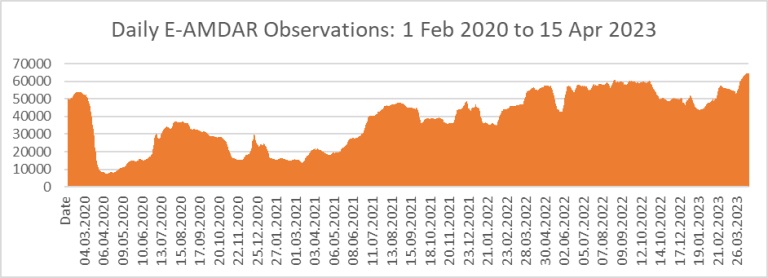
|

Total monthly ABO by type in EUCOS area (90° to 10°N, 40°E to 70°W)
|

|
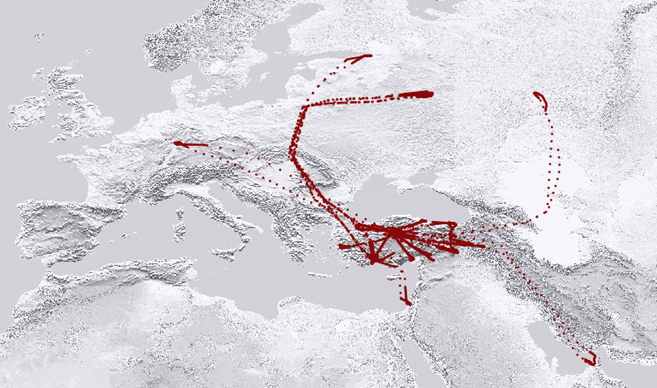
|
Issues
steve [dot] stringer |
ABOP Water Vapor MeasurementGlobal Water Vapor Measurement Summary and Update After three years of reduced aircraft-based observations (ABO) of water vapour due to the COVID-19 pandemic, operations of water vapour sensor-equipped aircraft are mostly back to normal. During the last two decades, two distinct sensor systems have been used to make these measurements: the Second-Generation Water Vapor Sensing System (WVSS-II) and Tropospheric Airborne Meteorological DAta Reporting (TAMDAR). WVSS-II No new installations of WVSS-II occurred during the last year. The number of functioning WVSS-II units on commercial aircraft in RA-VI (Europe) remained constant at nine. Operationally equipped aircraft in RA-IV (North America) also held steady at 131 since the October 2022 newsletter. The table below shows the breakdown of WVSS-II reporting aircraft across all WMO Regions. 
|
UPS and Southwest Airlines operate the WVSS-II-equipped aircraft in North America and Lufthansa in Europe. As in the past, the NOAA/NWS and EUMETNET-ABO (E-ABO) networks provide water vapour measurements (WVM) predominantly from their respective geographic regions (RA-IV and RA-VI). However, the participating airlines routinely travel outside the confines of their home territory, providing ABO WVM data over regions with otherwise no WVSS-II data, e.g., Region I (Africa) and Region III (South America). The following figure shows 24-hour global WVSS-II data coverage on March 29, 2023. 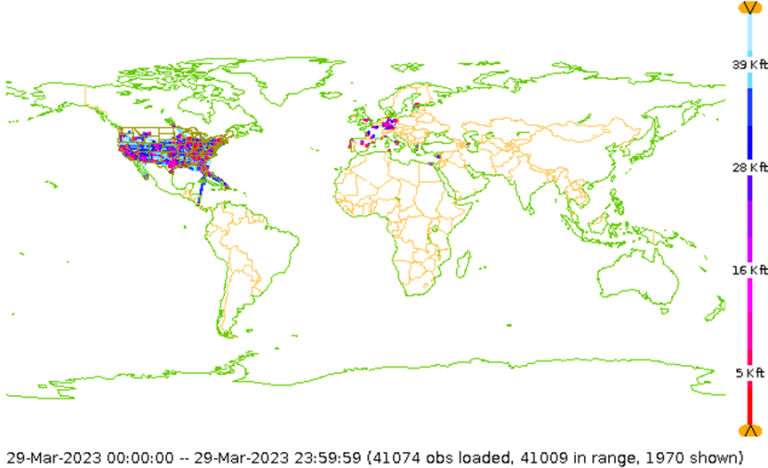
|
Regional Coverage of Water Vapour Measurement Under the USA ABO programme, RA IV continues to have 131 aircraft from Southwest Airlines and the United Parcel Service equipped with WVSS-II sensors. Typical daily water vapor profile numbers remain at approximately 1000. All nine WVSS-II-equipped aircraft (all A321 airframes) in RA-VI are back in service. E-ABO and airline partner Lufthansa Group share operations within the E-ABO network. The following figure shows the RA-VI coverage of WVSS-II data over a one-week period (March 23–29, 2023). 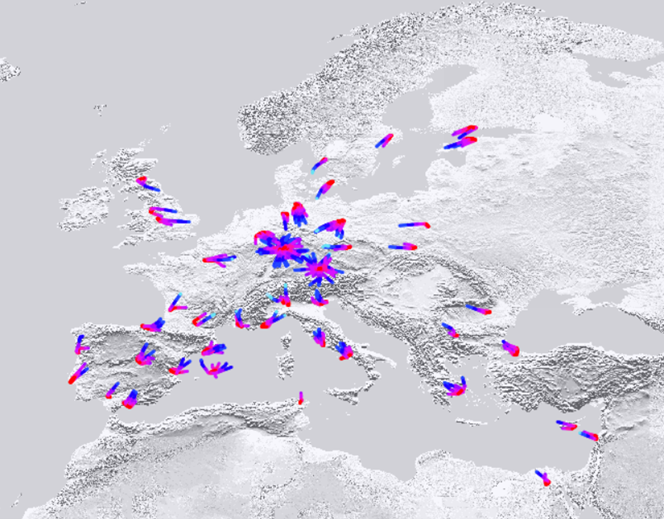
The main hubs for these aircraft are Frankfurt and Munich, each with a relatively high density of vertical profiles. However, these aircraft also fly to most countries within Europe on a routine basis. The UK Met Office is investing in new observation data sources to support its developments in supercomputing and high-resolution modelling to improve weather and climate forecasting. This includes plans to increase humidity measurements by installing sensors on commercial aircraft which would provide profiles similar to those already measured in the AMDAR programme and improve the coverage and frequency of measurements over the UK. |
TAMDAR FLYHT currently collects data from 129 active TAMDAR-equipped commercial aircraft. The breakdown of active TAMDAR aircraft by WMO region is shown below. 
|
In February 2023, these aircraft generated on average 581 TAMDAR soundings per day with the highest concentration of profiles found over the Southwest Pacific and Asia followed by North America. Sixty-six of the 129 active aircraft reported TAMDAR observations in February. The map below shows the TAMDAR observations for February 2023. 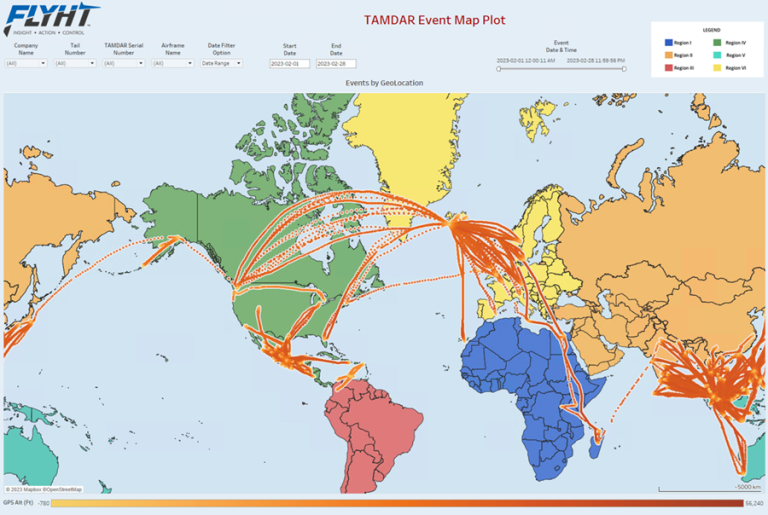
Carmen [dot] Emmel |
WMO Uncrewed Aircraft Systems Demonstration Campaign | |
| WMO, under the Joint Expert Team on Aircraft-Based Observing Systems has developed the scope and terms of reference for the WMO Uncrewed Aircraft Systems Demonstration Campaign (UAS-DC), for which the plan was endorsed by the WMO Commission for Observation, Infrastructure and Information Systems (INFCOM) Management Group in March 2022. | 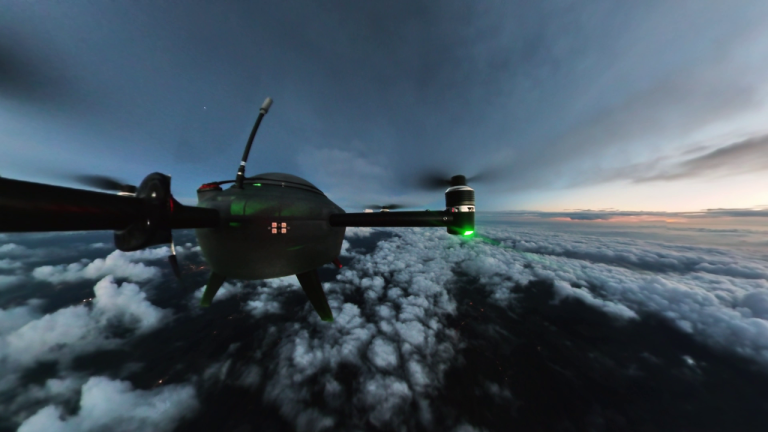
|
The UAS-DC will be held over March to August 2024 and aims to demonstrate the capability of UAS to provide data of sufficient quality and reliability on a routine operational basis in support of meeting requirements for upper-air observations, as a component system of the WIGOS Global Basic Observing Network (GBON). Plans for the UAS-DC continue to develop, with interest being piqued by a number of media articles in the past several months.
An important achievement earlier in 2023 has been the finalisation of the WMO White Paper, A Global Demonstration Campaign for Evaluating the Use of Uncrewed Aircraft Systems in Operational Meteorology, which describes in detail the current status of UAS technology and advancements required to ensure its readiness as a contributing observing system of the WMO Integrated Global Observing System (WIGOS). A pre-publication version of the White Paper is availble from the UAS-DC site. Over the coming months the WMO UAS-DC Scoping Planning and Organising Committee will focus attention on advancing several key aspects of the campaign, including:
More information about the UAS-DC is available from the WMO Community Platform site. WMO can be contacted about the campaign via the email address uas-demo | |
RA-I Task Team on Aircraft-Based Observations and WICAP Workshop, December 2022The WMO Regional Office for Africa conducted a meeting of the RA-I, Africa, Task Team on Aircraft-Based Observations (TT-ABO) and a Workshop on the WMO-IATA Collaborative AMDAR Programme (WICAP) over 6 - 8 December, 2022 in Addis Ababa, Ethiopia. The meeting and workshop was held at the Hotel Elilly and kindly co-hosted by the Ethiopian Meteorological Institute (EMI). The workshop was opened by Mr Fetene Teshome, Director General of Ethiopian Meteorological Institute and Permanent Representative (PR) of Ethiopia with WMO, Mr. Amos Makarau, WMO Director of Regional Office for Africa, Mr Anthony Rea, WMO Director of Infrastructure Department (online) and Mr Abubakr Salih Babiker, WMO Technical Coordinator for Infrastructure in Africa. 
The meeting of the RA I Task Team on Aircraft-Based Observations (TT-ABO), which preceded the workshop on WICAP, was chaired by Mr Mosetlho, South Africa. The purpose of the workshop following the meeting was to exchange experiences, best practices and status of national aircraft-based observations programmes, and to discuss the challenges and opportunities at the national and regional level for extending AMDAR under the developing RA-I WICAP programme in collaboration with IATA and regional airlines. National reports on aircraft-based observations were received from TT-ABO experts from South Africa, Egypt, Ethiopia, Morocco, Kenya and Cote D'Ivoire. The key recommendations that were proposed from the workshop are summarised below.
|
JET-ABO and Coordination Group on WICAP Priority ActivitiesOver 2022 and taking into account the approach of the coming new WMO Congress and constituent body inter-sessional period (2024 to 2027), the Joint Expert Team on Aircraft-Based Observing Systems (JET-ABO) and the Coordination Group on the WMO-IATA Collaborative AMDAR Programme (CG-WICAP) have reviewed their respective work plans and have established some expected priorities to be addressed. For the JET-ABO, as reported in the last newsletter, the priority activities associated with extension of aircraft-based observing systems will focus on:
From a WMO programmatic and data management perspective, additional activities would be expected to include:
For the CG-WICAP, which in particular has the role of supporting development of AMDAR over data-sparse areas, activities will focus on:
WMO will in the future continue to seek support from Members for the ongoing development of the Aircraft-Based Observations Programme as a component of the activities of the Commission for Observation, Infrastructure and Information Systems (INFCOM). Dean Lockett, Scientific Officer |
ADS B as a Source of Global Aircraft-based Observations DataIn 2017, the Harvard Business Review reported that, “Every year, weather variability is estimated to cost $630 billion for the U.S. alone, or 3.5% of GDP.” Forbes’ reporting on Deloitte’s 2021 Climate Check Survey, notes that, “Climate change and extreme weather events…have a direct impact on 70% of all economic sectors worldwide.” Better anticipation of impending weather through greater understanding of the atmosphere is critical to mitigating the negative effects and taking advantage of the opportunities associated with weather. Safe and efficient aircraft and aviation system operation requires knowledge of the atmosphere’s temperature, wind, icing, turbulence, and other parameters that are also critical to weather forecasting. Improved forecasting could increase aviation safety and capacity and reduce emissions by identifying hazardous weather and fuel-efficient routes. Often seen as part of the problem, aircraft operators can be part of the solution by sharing aircraft-based observations (ABO) data to lessen the impact of weather on the more than two-thirds of global economic sectors beyond aviation. Of the many inputs to numerical weather prediction models, ABO have one of the highest impacts of all observing systems, increasing both forecast accuracy and extending that accuracy in time. This makes possible earlier and more confident decisions related to weather and its impacts. ABO also provide an important record for climate change monitoring and prediction. Automatic Dependent Surveillance – Broadcast (ADS B) is a surveillance data link used by aircraft to broadcast their position, velocity, and other information in support of air traffic control and management. ADS B version 2 (V2) is required for aircraft operating in controlled airspace in Europe, in the United States, and in many other countries across the globe. ADS B version 3 (V3) standards that incorporate new requirements for ADS B Weather (ADS B Wx) were finalized for both 1090 MHz and Universal Access Transceiver (UAT) avionics in 2022. ADS B Wx enables the collection of ABO data using aircraft avionics and air traffic surveillance networks and could dramatically increase ABO availability and markedly reduce their cost. ADS B Wx is comprised of two independent capabilities, each of which is specified as optional for ADS B V3 avionics. ADS B Wx Air Reports (AIREP) use automated input from onboard systems to continuously broadcast meteorological and other information without action by the flight crew. ADS B Wx Pilot Reports (PIREP) rely on the flight crew to manually confirm input data prior to its broadcast by ADS B avionics. 1090 MHz ADS B Wx AIREP messages are automatically and continuously broadcast for use by ground-based weather forecasting and air traffic applications and by flight-deck based applications for hazardous flight condition avoidance and air traffic management. The raw data in ADS B Wx PIREP messages require ground-based processing to validate their data, correlate them in space and time, and generate standardized reports for dissemination to users through existing networks, including via ground-to-air data link services such as Flight Information Services – Broadcast (FIS B). ADS B Wx PIREP could also increase pilot weather reports while reducing human error, controller workload, and processing times associated with their collection and dissemination. The following table shows the ADS-B Wx AIREP parameters and their broadcast interval, by message, for 1090 MHz ADS-B V3. UAT ADS B V3 avionics broadcast similar ADS B AIREP information at rates that provide comparable reception probability to 1090 MHz ADS B systems. When equipped with ADS-B Wx AIREP capable avionics, aircraft are expected to broadcast only those parameters for which they are equipped.
| ||||||||||||||||||||||||||||||||||||||||||||
ADS B Wx development was coordinated with the meteorological community, research and standards organizations, aircraft and avionics manufacturers, aircraft operators, and other stakeholders. These efforts resulted in international consensus on ADS B Wx requirements and support for its implementation. The U.S. Federal Aviation Administration (FAA) has published Technical Standards Orders (TSO) that incorporate the ADS B Wx AIREP and PIREP capabilities and are necessary for certification of ADS B V3 avionics. The FAA is working to modify the U.S. ADS B Rule to allow the use of ADS B V3 avionics to comply with rule requirements. Europe is working on similar initiatives. 18 months after the U.S. rule change, manufacturers will no longer be able to seek U.S. certification of ADS B V2 avionics. International Civil Aviation Organization requirements for ADS B V3, including those for ADS B Wx AIREP and PIREP, are expected to become effective in 2026. Avionics manufacturers are developing ADS B V3 avionics. Mode S transponders operated in European airspace are currently required to implement both the ADS B V2 and Enhanced Surveillance (EHS) optional capabilities. Mode S transponders implementing ADS B V3 and EHS, but not ADS-B Wx AIREP, are required to broadcast the ADS B Wx AIREP Alternate Weather State message, which will allow air navigation service providers with ADS B receiver networks to eliminate Mode S interrogations for those data, reducing 1090 MHz spectrum congestion. The FAA is working to enable the U.S. ADS B ground receiver network to receive and process ADS B V3 messages, including ADS B Wx messages, in 2024. Aireon, LLC, has already modified its satellite payloads that provide global, space-based ADS B message reception to receive ADS B V3 messages, making global reception of ABO possible, including in areas without ground-based infrastructure. The U.S. National Transportation Safety Board (NTSB) has recommended that the FAA require air carriers to operate with ADS B Wx capable avionics. United Airlines and the Air Line Pilots Association have recommended that ADS B Wx functionality be specified as required, rather than optional, for ADS-B V3 avionics. The World Meteorological Organization, the U.S. National Weather Service and its Aviation Weather Center, and others, have made similar avionics requirements recommendations to the FAA and support the NTSB ADS B Wx implementation recommendations. Stephen Darr, Dynamic Aerospace Inc. | ||||||||||||||||||||||||||||||||||||||||||||
Synoptic Data’s Role in the Aircraft-Based Observations CommunityAs the JET-ABO community is well aware, aircraft-based observations (ABO) are one of Synoptic Data is a leader in environmental data aggregation with data from more than As the prime subcontractor of the National Mesonet Program, a preeminent public-private-academic partnership, Synoptic aggregates data from 50+ partners across the Synoptic continues to engage with like-minded individuals both domestically and elizabeth [dot] wilson |
Development of the Aircraft Based Observations Metadata RepositoryOver the past 14 months, WMO has been working with developer Wishtree Technologies on the implementation of the ABO Metadata Repository (ABO-MR), which will support the provision by WMO members of aircraft-based observational metadata in line with the requirements established in WMO No. 12, Guide to Aircraft-based Observations, Appendix D, Guidance on Aircraft-based Observations Metadata Maintenance and Provision. This initiative is being funded by contributions made to the AMDAR Operating Fund, with phase one of the development expected to cost around 100k CHF, providing the functionality to support:
Phase 1 of the ABO-MR is expected to be completed by mid-2023, with training of program managers on the use of the system expected to commence in 2024. The ABO-MR has been developed to meet requirements of data users to be able to better trace the origin of ABO data, to report on data quality issues and to undertake application level quality control based on improved ABO metadata access. Dean Lockett, Scientific Officer |
Contacts | |
WMO INFCOM, Joint Expert Team on Aircraft-Based Observing Systems Contacts Chair Vice-chairs carmen [dot] emmel nrivaben | WMO AMDAR Observing System Newsletter Editor ceweiss1949 WMO Aircraft-based Observations dlockett |
Subscription & Links
| |


